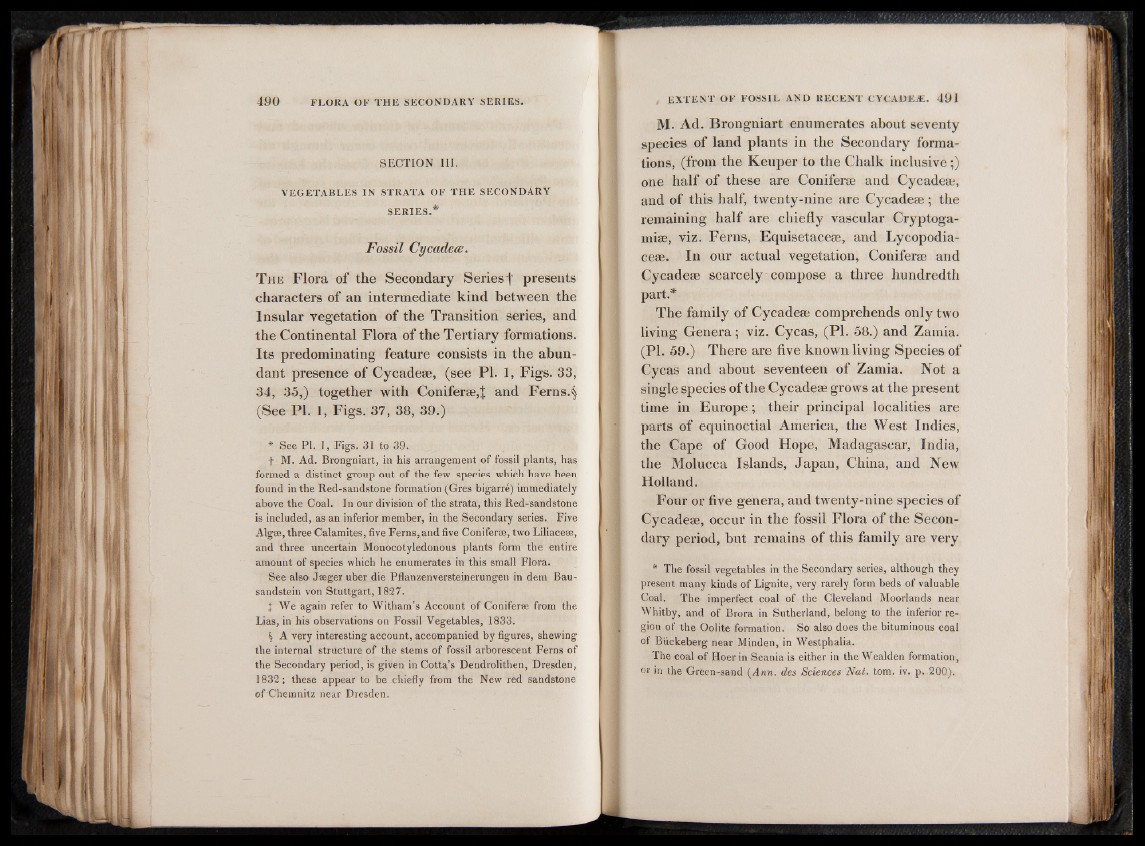
SECTION III.
VEGETABLES IN STRATA OF THE SECONDARY
SERIES.* *§
Fossil Cycadece.
T he Flora of the Secondary Series f presents
characters of an intermediate kind between the
Insular vegetation of the Transition series, and
the Continental Flora of the Tertiary formations.
Its predominating feature consists in the abundant
presence of Cycadese, (see PI. 1, Figs. 33,
34, 35,) together with Coniferse,! and Ferns.§
(See PI. 1, Figs. 37, 38, 39.)
* See PI. 1, Figs. 31 to 39.
t M. Ad. Brongniart, in his arrangement of fossil plants, has
formed a distinct group out of the few species which have been
found in the Red-sandstone formation (Gres bigarré) immediately
above the Coal. In our division of the strata, this Red-sandstone
is included, as an inferior member, in the Secondary series. Five
Algæ, three Calamites, five Ferns, and five Coniferæ, two Liliaceæ,
and three uncertain Monocotyledonous plants form the entire
amount of species which he enumerates in this small Flora.
See also Jaeger uber die Pflanzenversteinerungen in dem Bau-
sandstein von Stuttgart, 1827.
I We again refer to Witham’s Account of Coniferæ from the
Lias, in his observations on Fossil Vegetables, 1833.
§ A very interesting account, accompanied by figures, shewing
the internal structure of the stems of fossil arborescent Ferns of
the Secondary period, is given in Cotta’s Dendrolithen, Dresden,
1832; these appear to be chiefly from the New red sandstone
of "Chemnitz near Dresden.
M. Ad. Brongniart enumerates about seventy
species of land plants in the Secondary formations,
(from the Keuper to the Chalk inclusive;)
one half of these are Coniferse and Cycadese,
and of this half, twenty-nine are Cycadese; the
remaining half are chiefly vascular Cryptoga-
mise, viz. Ferns, Equisetacese, and Lycopodia-
cese. In our actual vegetation, Coniferse and
Cycadese scarcely-compose a three hundredth
part*
The family of Cycadese comprehends only two
living Genera; viz. Cycas, (PI. 58.) and Zamia.
(PI. 59.) There are five known living Species of
Cycas and about seventeen of Zamia. Not a
single species of the Cycadese grows at the present
time in Europe; their principal localities are
parts of equinoctial America, the West Indies,
the Cape of Good Hope, Madagascar, India,
the Molucca Islands, Japan, China, and New
Holland.
Four or five genera, and twenty-nine species of
Cycadese, occur in the fossil Flora of the Secondary
period, but remains of this family are very
* The fossil vegetables in the Secondary series, although they
present many kinds of Lignite, very rarely form beds of valuable
Coal. The imperfect coal of the Cleveland Moorlands near
Whitby, and of Brora in Sutherland, belong to the inferior region
of the Oolite formation. So also does the bituminous coal
of Biickeberg near Minden, in Westphalia.
The coal of Hoer in Scania is either in the Wealden formation,
or in the Green-sand (Ann. des Sciences Nat. tom. iv. p. 200).